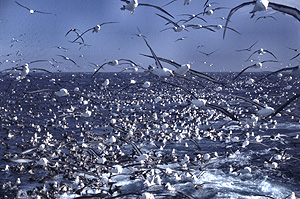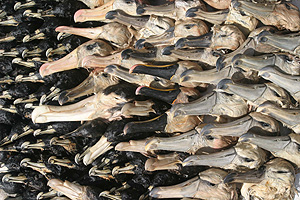Huge numbers of fish, seabirds, and other marine animals are routinely killed and discarded after being inadvertently caught during fishing operations. Known as marine bycatch, this problem is an ongoing challenge to the fishing industry, regulatory agencies, and conservationists. One recent proposal would compensate for bycatch by reducing other impacts on affected species, but a new analysis suggests that this strategy could end up doing more harm than good.
A paper published last year in Frontiers in Ecology and the Environment made the case for "compensatory mitigation" of fisheries bycatch, using seabird deaths caused by a longline fishery as an example. The authors suggested that eradicating rats from an island with seabird nesting colonies could have more benefits for a population of shearwaters than efforts to reduce bycatch in the longline fishery.
A number of seabird experts, however, were skeptical of the paper's findings. Given its potential influence on fishery policies, they decided the proposal warranted a careful evaluation.
"There are so many complexities involved in fisheries bycatch, we felt compelled to thoroughly examine the strengths and weaknesses of this approach and establish the criteria that would have to be met for it to work," said Myra Finkelstein, a postdoctoral fellow in ecology and evolutionary biology at the University of California, Santa Cruz.
Finkelstein is the lead author of a paper published June 18 in the journal PLoS ONE that evaluates the potential effectiveness of compensatory mitigation for marine bycatch. She worked with a dozen coauthors whose areas of expertise include seabird conservation and ecology, marine bycatch, and mathematical modeling of wildlife populations. The researchers concluded that compensatory mitigation could only rarely succeed in reducing or offsetting the effects of marine bycatch.
"It's very difficult to make this work," Finkelstein said. "Most of the species threatened by bycatch evolved to live long and reproduce slowly. When bycatch kills adults, these populations just aren't capable of making up for it through increased reproduction. It really is about the bycatch."
Another major stumbling block is that bycatch typically involves a large variety of nontarget species, whereas compensatory mitigation actions are likely to affect only one or a few of those species.
"Marine bycatch is not a single-species problem," Finkelstein said. "So many nontarget species are caught in a given fishery that mitigating the effects on one species could lead to a bigger impact on other species."
The researchers also found flaws in the case study of flesh-footed shearwaters used to support the compensatory mitigation strategy in the original paper. But the bulk of the new paper is devoted to a set of five criteria for evaluating any proposals to implement such strategies. The researchers found that compensatory mitigation for marine bycatch is likely to be successful only in a limited number of situations. In many cases, they said, it has the potential to accelerate declines of marine species currently threatened by fisheries bycatch.
"These are complicated situations. We have to be very cautious, especially with critically endangered species, before we adopt a policy that allows continued mortality from bycatch," Finkelstein said.
The coauthors of the paper include Victoria Bakker, William Satterthwaite, and Robert Henry of UCSC; Daniel Doak of the University of Wyoming; Ben Sullivan and John Croxall of the BirdLife International Global Seabird Programme; Rebecca Lewison of San Diego State University; Peter McIntyre of the University of Michigan, Ann Arbor; Shaye Wolf of the Center for Biological Diversity; David Priddel of the Australian Department of Environment and Climate Change; Jennifer Arnold of Pennsylvania State University; and Paul Sievert of the University of Massachusetts, Amherst.
Note to reporters: You may contact Finkelstein at (831) 459-3902 or myraf@ucsc.edu.




